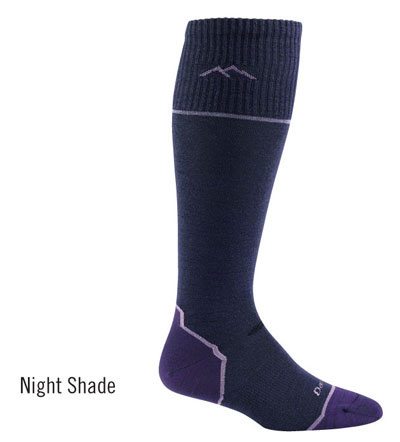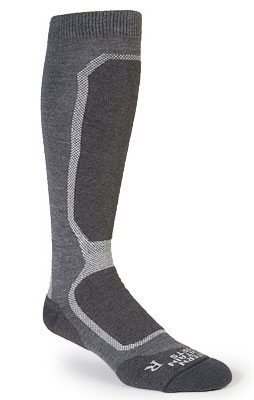 Julia Van Raalte: Darn Tough Over-the-Calf Ultra Light
Julia Van Raalte: Darn Tough Over-the-Calf Ultra Light
I am sure those who know me well are sick of my constant soliciting of Vermont-made products: local maple syrup, Ben and Jerry’s ice cream, Turtle Fur neck-warmers. But my most recent find has been the most exciting: Darn Tough socks.
First, let me explain a little bit of my sock history. I have always been a SmartWool loyalist. In my ski racing days, my go-to sock was the classic black SmartWool Ski PhD Ultra Light. They were thin but not too tight, which made them the best sock I could find to maintain circulation in my toe-crushing boots. I always found that although they were much thinner, because I had more space in my boots, my feet stayed warmer. I also never had an issue with bunching around the toes. There was only one problem: after one season, the heels would wear through, and I would have a toe or two poking out the front. I continued to buy them season after season, however, for lack of a better option.
After I stopped racing, I continued to ski in my race boots, even though they were old and packed out. Since I had a little extra wiggle room, I decided to do some sock experimenting. I tried the SmartWool PhD Ski Light, but the cushioning was too bulky. I also spent some time in the new SmartWool PhD Ski Racer, which I preferred over the Ski Light. While there was still some padding on the shin and heel, it was much thinner to accommodate a tighter fitting race boot. SmartWool is also working to address the durability issue that plagued the Ski Ultra Light, and the Ski Racer claims a tougher construction. Though it is not what I ended up skiing in every day, it was a comfortable and thinner alternative to the SmartWool PhD Ski Light.
I stumbled across the Darn Tough Over-the-Calf Ultra Light several years ago and was excited to find a good-looking pair of socks that were both thin and didn’t have padding. (And did I mention they were from Vermont?) Three years and more than a hundred days on snow later, the socks still look brand new and are not worn through anywhere. They are the perfect weight and stretchiness, have virtually non-existent seams, and are extremely durable. Even though I have other socks in my drawer, last season I grabbed Darn Toughs almost every day (except when they were in the laundry).
 Garrett Altmann: Thorlo Moderate Cushion SLW Ski Sock
Garrett Altmann: Thorlo Moderate Cushion SLW Ski Sock
I like all five of Thorlo’s ski socks, but my go-to is the Moderate Cushion SLW Ski Sock. Recommended to me years ago by a boot fitter in Sun Valley, this sock has held up through 100-plus-day seasons, international competition, below-zero-degree days, summer skiing on the Blackcomb glacier, and everything between. I’ve always been open to trying new brands and materials from other companies, but so far, I haven’t found anything that’s compared in terms of quality, comfort, and durability. With a merino silk blend and cushioning applied only in areas of the heel, ball of foot, and shin (to minimize shin bang), this sock offers a comfortable, high-performance fit that actually makes me look forward to putting on my ski boots, rather than dreading the experience.
Thorlo is a small, 100% American company based in North Carolina that sources locally sustainable fibers from the southeastern U.S. Their products are milled at their company headquarters and are built in a carbon-neutral production process. They offer several styles and levels of thickness, for all types of sports and everyday use. While they are not the least expensive socks on the market, I’m never disappointed by the quality, comfort level, and durability they provide.
Will Brown: Synthetic Weave Thorlos
I care very little about socks. All that matters to me is that they’re thin—I don’t get cold feet, and prefer a close precise fit in my boots (which don’t allow much room for extra material between my foot and the liner). While they’re very nice, I don’t usually buy SmartWool because they’re pricey, and thin socks tend to wear out rather quickly under the heel and the ball of the foot. Instead I usually go with synthetic weave Thorlos or something similarly affordable.
Most of my ski socks are classified as “thin,” though I do have one pair of “ultra thins” and a couple of pairs (that I never wear) that could be classified as “thick.”
Thin socks are the only way to go. They leave a small bit of dead air space for warmth and allow for maximum sensation transmission from your boot to your foot and vice versa. I use the ultra thins in my Dalbello KR2s because I have absolutely no room to spare in the boot (it’s a pencil shell fit). I wore thin Icebreaker’s one day in the KR2, which left me with a beautiful black toe I’ll have to live with until August or so, when the nail falls off. My Nordica’s are just big enough that I can wear the thin socks I have from Icebreaker, SmartWool, and EMS (Eastern Mountain Sports). My favorites are the EMS socks, because they fit my foot the best, are the warmest, never wrinkle, and have a double layer on the shin for a tad of plushness.
Stella Selden:
To be honest, I can’t remember the last time I bought myself ski socks. They tend to be one of my family’s favorite stocking stuffers, so I usually get whatever size, brand, and pattern you can imagine. When I pick through my sock collection each day, I usually am looking for two things: warmth and comfort. Personally I prefer thicker socks to keep my feet warmer, as well as to fill extra space in my ski boots that have packed out liners.
I also like socks that fit properly from my toes to my heel. It’s never comfortable if that area of the sock is a little too long and the heel of the sock is on your achilles. I also have larger calves, so a wider sock feels less restricting. In general, if a sock fits my foot and calf properly and is thick enough to fill space in my boot to provide a little extra warmth, I’m good to go. Also, the more colors and crazy patterns, the better!
Kate Hourihan:
I actually tend to not be too picky about my socks, but imagine that 90% of the time I am skiing in SmartWools. I seem naturally to avoid more bulky, thick socks that I have somehow acquired and tend to just stick with something simple and light. I also have had a few pairs of Solomon socks recently, which I have liked. In particular, these socks which almost look like they are made out of a stocking-like material that is really stretchy and light. And in general I’d say, especially for the backcountry, I want a sock that won’t turn into a sponge by the end of the day.
 Jonathan Ellsworth: SmartWool PhD Ultra Light
Jonathan Ellsworth: SmartWool PhD Ultra Light
I own a number of different brands and styles of socks (Icebreaker, SmartWool, Darn Tough, CEP Compression), and I don’t hate any of them.
But every time I’m about to go ski, I am digging through my sock drawer to see if there isn’t one pair of SmartWool PhD Ultra Lights that isn’t in the dirty laundry pile. And to be honest, if I can’t find a clean pair, I’ll usually decide that I can get one more day of skiing out of the pair on top of that laundry pile. Gross? Yeah, sort of; but these are wool, and they aren’t quick to get funky. Above all, I suppose it says how much I like these socks, and for one reason: they’re thin.
I’ve drunk the Kool Aid that says that, when it comes to ski boots, the thinnest sock is actually the warmest sock.
Clearly, the choices of some of our other reviewers is evidence that not everybody abides by this rule, but I still buy it. A very thin sock ought to permit better circulation for the foot, and poor circulation is one of the common causes of cold feet—which can also be produced by overtightening the bottom two buckles of your ski boots.
I wear a pretty tight boot, and there isn’t a lot of extra space. Then I wear a very thin sock. Then I go ski, and very rarely am I bothered by cold feet and toes.
If there is a downside to the SmartWool PhD Ultra Lights, it is, as others have mentioned, the fact that super thin does not amount to super durable. Over time, I do tend to get holes in them. But I keep buying new ones because I’m hooked on the fit and feel, and I’m not interested in compromising.
The most durable socks I’ve used to date are made by Darn Tough. They are excellent socks, and if you don’t mind going with a slightly thicker sock, then, in my experience, you will get an increase in durability. I guess it comes down to your budget and what flavor of Kool Aid you’re drinking.
NEXT: SNOWBOARD SOCKS


For what it’s worth, I openly admit to having pretty sweaty feet even when not working up a sweat. My feet have never felt drier throughout the day than when wearing Icebreakers. Warm is good – and they are that – but dry is key to daylong comfort.
I am disappointed that no one mentioned point 6 they are by far and away my favorite.
Point 6 is on our radar, Spencer, and we’ll hopefully be able to weigh in soon on how they stack up against some of our go-to products named above.